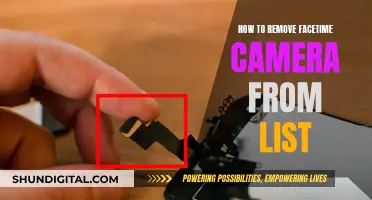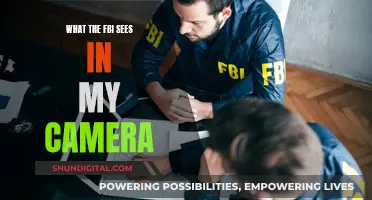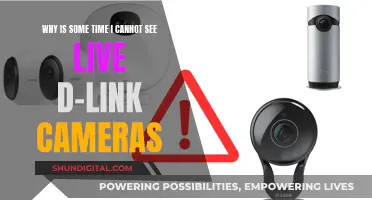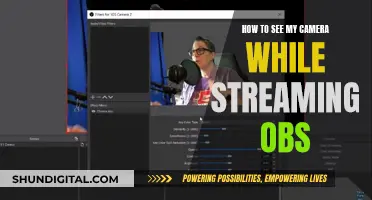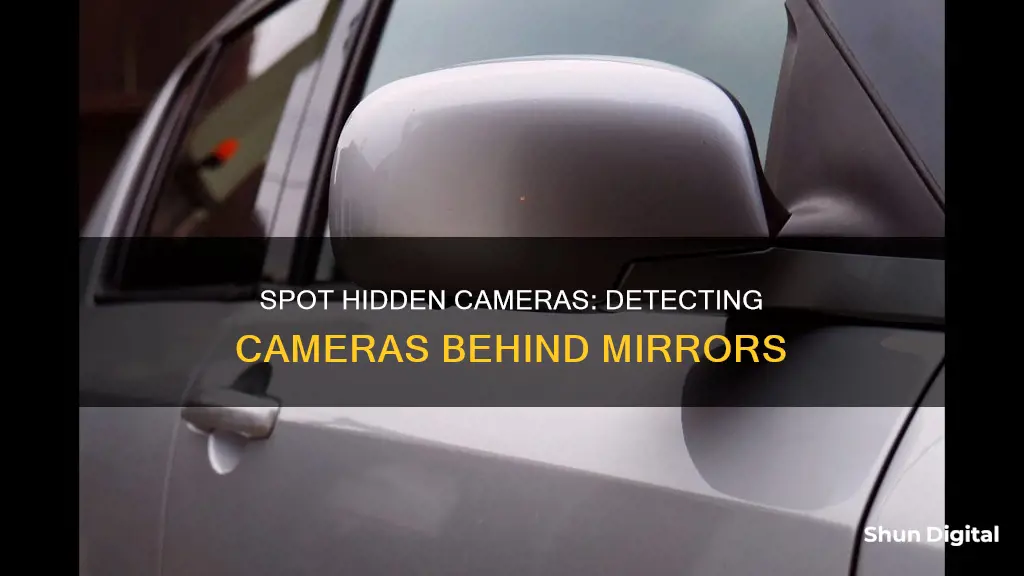
In today's world, it is easier than ever for someone to invade your privacy by installing hidden cameras in unsuspecting locations. This is a serious concern, especially when it comes to mirrors, as they can be used to observe private spaces. While there is no foolproof method to detect hidden cameras, you can look for several signs that may indicate their presence. Here are some ways to determine if a mirror has a camera:
- Examine the mirror closely for any unusual features, such as small pinholes or tiny camera lenses, especially near the edges.
- Observe if the mirror emits a strange glow or a faint red or green light, which could indicate a hidden camera.
- Pay attention to any unusual sounds or abnormal heat signatures coming from the mirror, as these may be signs of a built-in camera.
- Consider the location of the mirror. If it is placed strategically to observe private spaces, it could be a sign of a hidden camera.
- Trust your instincts. If something feels off about a mirror, investigate further.
- Use a flashlight to scan the mirror's surface at different angles, looking for any unusual reflections or distortions.
- Try the fingernail test by placing your fingernail on the mirror. If there is a gap between your fingernail and its reflection, it is likely a standard mirror. If they touch, it may be a two-way mirror.
- Check the Wi-Fi network to see if any unknown devices are connected, as wireless hidden cameras often connect to Wi-Fi.
- Use a professional hidden camera detector, which can identify radio frequency signals or infrared emissions from hidden cameras.
| Characteristics | Values |
|---|---|
| Observe the gap between your finger and the mirror | If there's a gap, it's a real mirror. If your finger and the image touch, there might be a hidden camera. |
| Observe the lighting | If the lighting in the room is relatively dim and you can't see through the mirror, it's probably a standard mirror. |
| Check the location | Two-way mirrors are frequently used by law enforcement. If you're in a public place where you'd expect privacy, it's unlikely and illegal to have a two-way mirror. |
| Peer through the glass | If the light in the observation room is brighter than the light on your side of the mirror, you should be able to see something beyond the glass. |
| Shine a light on the mirror | If it is a two-way mirror, the room on the other side will be illuminated and you'll be able to see it. |
| Sound it out | A normal mirror will produce a dull, flat sound, whereas an observation mirror will produce an open, hollow, and reverberating sound. |
| Perform the fingernail test | If there is a gap between your fingernail and the image, it's a second surface mirror. If you can touch your reflection, it's a first surface mirror. |
| Check the Wi-Fi network | Most wireless hidden cameras are connected to Wi-Fi. You can check how many devices are connected to the router to find hidden cameras. |
| Use a mobile phone | Make a call and walk around. If there is a hidden camera nearby, it will likely interfere with the phone call's signal. |
| Use a flashlight | Most hidden cameras have red or green LEDs that will blink or shine in low-light conditions. |
What You'll Learn

Examine the mirror closely for any unusual features or inconsistencies
Examining a mirror closely for unusual features or inconsistencies is a crucial step in detecting hidden cameras. Here are some detailed instructions to guide you through this process:
- Inspect the mirror's surface and frame meticulously, looking for any slight imperfections, inconsistencies, or unusual features. Pay close attention to the edges and crevices, as hidden cameras or pinholes lenses may be concealed in less noticeable areas.
- Be wary of any small holes, tiny camera lenses, or unusual wires on or near the mirror. These could be signs of a hidden camera.
- Observe the mirror's behaviour. If it emits a strange glow or a faint red or green light, or if it produces a slight buzzing sound or abnormal heat signature, it may indicate the presence of a hidden camera.
- Consider the location and positioning of the mirror. If it is placed strategically in an area where it can observe private spaces, such as bathrooms, changing rooms, or bedrooms, it could be a sign of a hidden camera.
- Trust your instincts. If something feels off about the mirror, further investigation is warranted. Your intuition can often identify potential privacy violations.
- Use your fingers to feel for any irregularities or loose parts on the mirror's surface, frame, or edges that could indicate tampering or the presence of a hidden compartment.
- Examine the mirror with a magnifying glass to identify potential hidden cameras that may be too small to see with the naked eye, such as tiny lenses or wires.
- Try tapping on the mirror lightly. A hollow or unusual sound could suggest the presence of a hidden compartment or camera.
Remember, these signs are indications for further investigation. Combining physical inspection with other detection methods, such as using a flashlight or seeking professional assistance, will provide more comprehensive results.
Syncing iPad Camera to MacBook: A Step-by-Step Guide
You may want to see also

Check for a strange glow or faint red/green light
Checking for Strange Lights or Glows
If you suspect a mirror may have a hidden camera, one of the things you can look out for is a strange glow or faint red or green light. Here are some detailed steps to help you with this process:
Turn Off the Lights
Before you start looking for strange lights or glows, it's important to turn off all the lights in the room. This will create a darker environment, making it easier to spot any unusual lighting coming from the mirror.
Use Your Mobile Phone
Your mobile phone can be a useful tool in this process. Turn on your phone's camera and use it to search around the room, paying close attention to the mirror. Look for any blinking or shining red or green LEDs near the mirror's frame. These LEDs are commonly found on hidden security cameras and will be more visible in low-light conditions.
Draw the Curtains
To further enhance the lighting conditions, draw the curtains in your room. This will prevent external light sources from interfering with your inspection and make it easier to spot any unusual lights coming from the mirror.
Observe Carefully
Now, carefully observe the mirror. Look for any strange glows or faint red or green lights emitting from the mirror's surface or frame. These could be indicators of a hidden camera. Remember that hidden cameras are often cleverly disguised, so you may need to look closely to spot any unusual lighting.
Inspect the Surroundings
In addition to observing the mirror itself, take a step back and inspect the surrounding area. Look for any reflective lights or suspicious wires that could be connected to a hidden camera. Pay attention to any unusual objects or inconsistencies in the room that could be hiding a camera.
Trust Your Instincts
If something feels off or you have a gut feeling that the mirror may have a hidden camera, don't ignore it. Your intuition can be a powerful tool, so it's important to investigate further and take the necessary steps to protect your privacy.
Selfie Camera Eclipse Viewing: A Safe and Easy Guide
You may want to see also

Listen for a buzzing sound or abnormal heat signature
If you suspect a mirror may contain a hidden camera, one method of detection is to listen for a buzzing sound or abnormal heat signature. This method is most effective in a quiet environment, as the sound emitted by hidden cameras is often faint and hard to detect. Turn off any other electronic devices in the vicinity to minimise background noise and improve your chances of hearing the camera.
The sound of a hidden camera can be described as a faint buzzing or clicking noise. It may be intermittent, only occurring when the camera is active, so it is worth testing the mirror by covering and uncovering it to see if this triggers any sounds. If you are still unsure, try moving around the room, as your angle in relation to the mirror may impact whether you can hear the noise.
The best time to listen for a buzzing sound is at night, when there is less external noise to interfere with your detection. If you are in a new place, such as a hotel, and are concerned about your privacy, it is worth taking the time to scan the room for any unusual sounds or heat signatures that could indicate the presence of a hidden camera.
In addition to listening for a buzzing sound, you can also try knocking on the mirror with your knuckles and observing the resulting sound. If it seems hollow and reverberating, this may indicate that there is an open space behind the mirror, suggesting a two-way mirror or hidden camera. However, keep in mind that not all hidden cameras make noise, so this method may not always be effective.
If you are unable to detect any unusual sounds or heat signatures, there are other methods you can try to detect a hidden camera, such as using a RF detector or checking for unusual wires or decorations.
Spotting Cameras: Tips to Identify Them Discreetly
You may want to see also

Observe the location and positioning of the mirror
When checking if a mirror has a camera, it's important to observe the location and positioning of the mirror. Hidden cameras are often strategically placed in areas where private spaces can be observed, such as bathrooms, changing rooms, or bedrooms. If you notice a mirror in a place where it can capture your private activities, it could be a sign that it contains a hidden camera.
Additionally, consider the lighting conditions in the room. Two-way mirrors, which are often used for hidden cameras, require the light on the mirrored side to be significantly brighter than the light on the other side. If the lighting in the room is relatively dim, and you can't see through the mirror, it's probably just a standard mirror.
Also, pay attention to the way the mirror is installed. If the mirror seems to be hanging on the wall, try to look behind it to see if there is a wall. If the mirror appears to be part of the wall itself, there's a higher chance it could be a two-way mirror.
You can also try to peer through the mirror by cupping your hands around your face and pressing it against the glass. If the light in the room behind the mirror is brighter than the light on your side, you may be able to see through the mirror.
Furthermore, you can shine a light on the mirror. Turn off the lights in the room and hold a flashlight or the "flashlight" on your smartphone against the mirror. If it is a two-way mirror, the room on the other side will be illuminated, and you will be able to see it.
By observing the location and positioning of the mirror, as well as considering the lighting conditions and installation, you can gain valuable insights into the possibility of a hidden camera.
Stream Zmodo PoE Cameras on Your Fire Stick
You may want to see also

Use a flashlight to scan the mirror's surface
Using a flashlight to scan the mirror's surface is a common method to detect hidden cameras. Here are some detailed steps to effectively use this technique:
Firstly, it is recommended to turn off the lights in the room to create a darker environment. This helps to reduce the potential for light reflections that could interfere with your inspection.
Then, take out your flashlight, preferably one with a strong and focused beam. If you don't have a regular flashlight readily available, you can also use the flashlight function on your smartphone. Position yourself close to the mirror and slowly shine the flashlight across the entire surface of the mirror. It is important to change the angle of the light as you scan, as certain angles may reveal suspicious reflections that others do not.
When scanning, pay close attention to any unusual reflections, glares, or distortions on the mirror's surface that do not match the surrounding environment. These anomalies could indicate the presence of a hidden camera lens. Be thorough and methodical in your search, taking your time to inspect every section of the mirror from various angles.
Additionally, some hidden cameras may have a blinking red or green LED light, which can be easier to spot in a dark room. Keep an eye out for any such lights during your scan, as they could be a telltale sign of a hidden camera.
While this method is useful, it is important to note that it may not always be completely reliable. Hidden cameras and their lenses are becoming increasingly small and well-disguised, making them more challenging to detect. Combining this technique with other methods, such as physical inspection or using a dedicated hidden camera detector, can increase your chances of success.
TCL 4K Roku TV: Camera and Microphone Features Explored
You may want to see also
Frequently asked questions
There are several ways to check if there's a camera hidden in a mirror. One common method is to look for any small pinholes or camera lenses on the mirror's surface, especially near the edges. You can also try the "fingertip test" by placing your fingertip on the mirror; if there's no gap between your fingertip and its reflection, it's likely a two-way mirror. Additionally, you can use a flashlight or the camera on your phone to scan the mirror's surface for any unusual reflections that may indicate the presence of a camera lens.
Aside from physical indicators, such as small pinholes or camera lenses, there are other signs that may suggest the presence of a hidden camera in a mirror. This includes unusual behaviour from the mirror, such as a strange glow or a faint red or green light. Mirrors with built-in cameras may also produce a slight buzzing sound or have an abnormal heat signature.
If you discover a hidden camera in a mirror, it is important to take immediate action. Do not touch or move the camera, as this may disturb any potential evidence. Instead, take photos of the camera for documentation. Contact the authorities, such as the police, and report your findings. They will be able to provide further guidance and investigate the matter.


